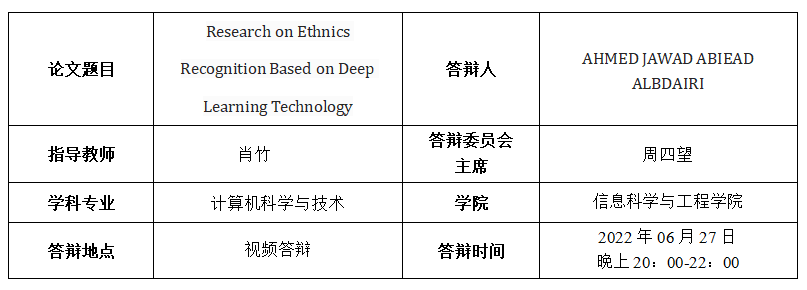毕业答辩公告

学位论文简介
In the past ten years, the interest in face recognition research has grown rapidly. One of the most important issues in face recognition is ethnics recognition. In this research, a new deep learning convolutional neural network was designed to create a new model that can recognize people's ethnicity through facial features. The new ethnic dataset is 3141 people collected from three different ethnic groups. As far as we know, this is the first image dataset collected for ethnic minorities, and this dataset will be available to the research community. The new model was compared with the latest models of VGG and Inception V3, and the verification accuracy of each convolutional neural network was calculated. The generated model was tested with multiple human images, and the results showed that the model achieved the best performance, with a verification accuracy rate of 96.9%.
Any research related to face recognition needs to go through four processes: face detection that can use to find the face in the image and mark it with a bounding box; face alignment to make the face consistent with the database, such as geometry and photometry; feature extraction, face recognition that uses the extracting facial features for matching them with the extracted facial features in a prepared database.
Face detection is one of the most important steps in the research of human face recognition. It can be seen as a prototype of computer vision technology, from machine learning (ML) to the development of increasingly complex deep neural networks and related technologies. It is the first step in key applications such as face tracking, face analysis, and face recognition, and therefore plays an important role in face recognition. In many face recognition systems, face detection has an important influence on the execution of sequence operations. In this article, we use a face detection to extract the entire face in any image in the first and fourth contributions and pass it to the model. In the second and third contributions, we used face detection, not detecting the entire face in any image, but detecting the middle part of the face. Since this part is the region of interest in these two contributions, it contains the eyes with small margins from the upper left corner to the lower right corner of the eye area.
After the face is detected in the image, the face can be aligned. It is a computer vision technology that can be used to recognize the geometric structure of a human face in an image. This technology uses face detection such as human eyes, nose, mouth, and ears. After detecting the human face, it can automatically determine the shape of the human face. Face alignment is achieved by iteratively adjusting a deformable model, which encodes prior knowledge of face shape or appearance to consider low-level image evidence and find the face that exists in the image.
主要学术成果
Ahmed Jawad A. AlBdairi, Zhu Xiao and Mohammed Alghaili. Identifying Ethnics of People through Face Recognition: A Deep CNN Approach. DOI: https://doi.org/10.1155/2020/6385281. (SCI)
AlBdairi, A.J.A.; Xiao, Z.; Alkhayyat, A.; Humaidi, A.J.; Fadhel, M.A.; Taher, B.H.; Alzubaidi, L.; Santamaría, J.; Al-Shamma, O. Face Recognition Based on Deep Learning and FPGA for Ethnicity Identification. Appl.Sci.2022,12,2605. https:// doi.org/10.3390/app12052605.(SCI)
Mohammed Alghaili, Zhiyong Li and Ahmed Jawad A. AlBdairi. Generating an Embedding Features using Deep Learning for Ethnics Identification. (accepted by IAENG International Journal of Computer Science ).